Background
For many remote off-grid communities, lack of access to clean water and reliable electricity are challenges for their economic development. Community owned and operated water systems powered by locally available renewable energy could be a step in overcoming these challenges. These systems need to be robust and cost effective in order to serve remote communities. Therefore, the goal is to design cost-effective, autonomous, robust, community-scale water purification systems powered by renewable energy.
Experimental batteryless PVRO system, later deployed in remote communities on the Yucatan Peninsula (Steven Dubowsky, Amy Bilton, Leah Kelley)
Modular Design Methods for Photovoltaic Reverse Osmosis (PVRO) Systems
Many water and energy systems are modular. Modular systems are advantageous because they be individually tailored based on local conditions and needs. However, modularity also means that there are many design choices that must be made when configuring solutions for small communities, and these design choices are often beyond the expertise of the community. Design tools which aid in modular design can greatly improve access to these technologies.
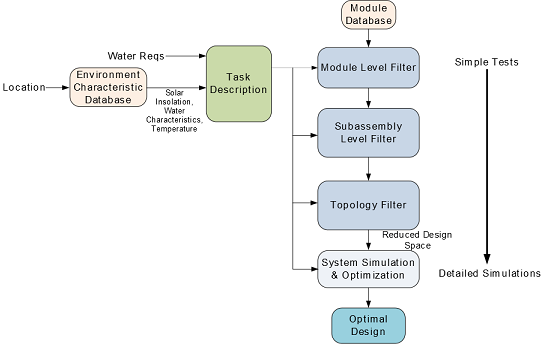 A modular water and energy system that has been studied by WERL is photovoltaic reverse osmosis (PVRO). Designing a PVRO system is challenging due to the complex non-linear behavior of the system, uncertainty in the energy source, and the enormous number of design choices that need to be made for even a small system. A designer with significant expertise is required to tailor a PVRO system for a given location, putting this technology out of reach of many communities. WERL’s research developed a modular design architecture to tailor PVRO systems from inventories of mass-produced modular components. To accommodate the large number of design choices, a hierarchical design method was developed, shown in the flowchart. The method uses a series of filters to limit the design space based on engineering principles and calculations. The system is then configured from the reduced design space using optimization methods and detailed system models. The design method also accounts for uncertainty in factors which affect the system performance, such as the solar radiation and water demand. A set of detailed physics-based system models were developed to enable this process. A novel method of representing a PVRO system using a graph was developed to enable rapid evaluation of different system configurations. This modeling technique was validated using an experimental PVRO system which was designed and constructed as part of this research.
A modular water and energy system that has been studied by WERL is photovoltaic reverse osmosis (PVRO). Designing a PVRO system is challenging due to the complex non-linear behavior of the system, uncertainty in the energy source, and the enormous number of design choices that need to be made for even a small system. A designer with significant expertise is required to tailor a PVRO system for a given location, putting this technology out of reach of many communities. WERL’s research developed a modular design architecture to tailor PVRO systems from inventories of mass-produced modular components. To accommodate the large number of design choices, a hierarchical design method was developed, shown in the flowchart. The method uses a series of filters to limit the design space based on engineering principles and calculations. The system is then configured from the reduced design space using optimization methods and detailed system models. The design method also accounts for uncertainty in factors which affect the system performance, such as the solar radiation and water demand. A set of detailed physics-based system models were developed to enable this process. A novel method of representing a PVRO system using a graph was developed to enable rapid evaluation of different system configurations. This modeling technique was validated using an experimental PVRO system which was designed and constructed as part of this research.
Real-time Identification of PVRO Fouling Dynamics
Membrane degradation in PVRO, in the form of inorganic scale or biological growth, commonly termed as fouling, is significantly impacting the maintainability of existing small-scale PVRO plants, thereby limiting their application. Previous works employing conventional fouling detection methods, such as flux decline, provided strong insights but did not explain the uncertainties in the fouling behavior due to the intermittent photovoltaic-powered application operation.
At WERL, we designed and fabricated a bench-scale RO visualization setup and integrated it with a custom-built semi-autonomous control and data acquisition system. Image acquisition and post-processing algorithms have been standardized through experiments. Scale developments observed through the system matched well with hypotheses from literature. Post-processing of the targeted scaling hotspots also presented critical insights about RO membrane degradation patterns. Presently, a convolutional neural network-based (CNN) analysis is being run on the image data to develop more insights into the patterns and intensity of membrane degradation due to spatial and temporal variations.
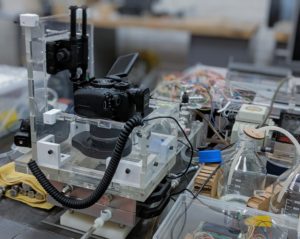 Macro-scale visualization in real-time helps to understand the onset and initial-level growth of membrane scaling
Macro-scale visualization in real-time helps to understand the onset and initial-level growth of membrane scaling
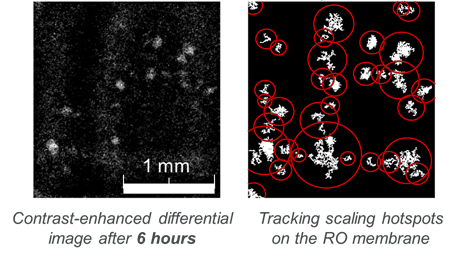 Real-time image postprocessing and scaling hotspots identification
Real-time image postprocessing and scaling hotspots identification
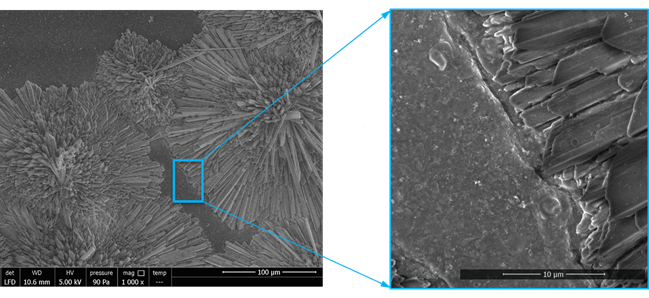 Unusual RO membrane degradation inspection under scanning electron microscopy
Unusual RO membrane degradation inspection under scanning electron microscopy
Development of a Data-Driven Fouling Model to Improve Overall RO System Lifetime and Operation
Forecasting future fouling and adapt to favorable operating conditions via statistical analysis of historical plant data is also an area less explored for PVRO. So, besides employing real-time computational photography to understand the PVRO degradation mechanisms, WERL is also developing data-driven control systems to improve the day-to-day operation of a community-scale PVRO. Together, the research outcomes will enhance the maintainability of PVRO and make it an affordable and sustainable solution for remote, off-the-grid communities. Major activities on this research include but are not limited to the optimization of critical operational parameters for PVRO, development of a data-driven model for the PVRO control and scale mitigation by employing SVM and ANN algorithms. Successful completion of the current study will optimize PVRO operation on a small-scale, improve membrane lifetime, and result in a less-expensive, easy-to-use, and self-adaptive clean water solution for everyone. Expansion and scaling-up of the technological findings can also promote photovoltaic-power for large-scale water desalination (which accounts for a significant amount of energy consumption and CO2 emission worldwide) and curb global CO2 emissions significantly.
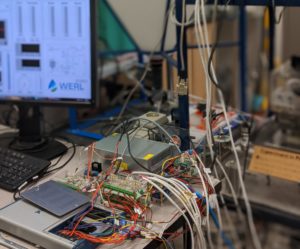 Data acquisition in pilot-scale PVRO operation
Data acquisition in pilot-scale PVRO operation
